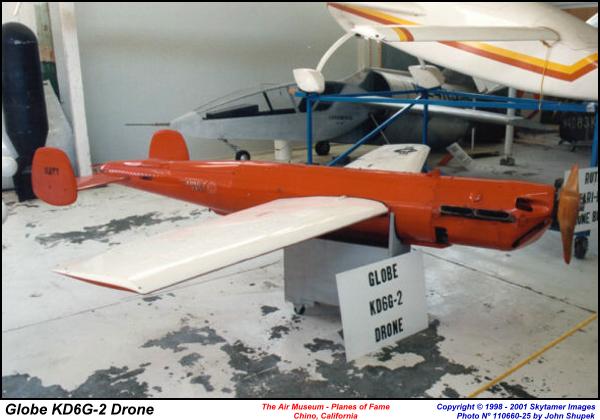Globe KD6G/MQM-40 Firefly
The KD6G was the last in a series of small low-cost target drones built by Globe in the immediate post-World War II era. The piston-engined KDG Snipe of 1946 was followed by the pulsejet-powered KD2G Firefly and KD5G, and the piston-engined KD3G Snipe and KD4G Quail.
The XKD6G-1 Firefly, which appeared in 1951, was based on the KD2G-2, but replaced the latter's PJ32 pulsejet with a McCullough O-100-1 piston engine. It was a ground-launched radio-controlled target of all-metal construction, which was recoverable by parachute. The XKD6G-2 was similar, but used the Kiekhaefer V-105-2 engine. The KD6G-1 and KD6G-2 production models were by far the most successful of Globe's targets, and were used throughout the 1950s for surface-to-air and air-to-air gunnery training.
 |
| Photo: Skytamer Images |
| KD6G-2 (XQM-40A) |
The KD6G-2 remained in limited use until the early 1960s. In June 1963, it was redesignated as XQM-40A, but the final designation of the drone was apparently MQM-40A.
Specifications
Note: Data given by several sources show slight variations. Figures given below may therefore be inaccurate!
Data for KD6G-2 (XQM-40A):
| Length | 3.50 m (11 ft 6 in) |
| Wingspan | 3.50 m (11 ft 6 in) |
| Finspan | 1.09 m (3 ft 7 in) |
| Height | 0.48 m (1 ft 7 in) |
| Speed | 425 km/h (265 mph) |
| Endurance | 60 min. |
| Propulsion | Kiekhaefer V-105-2 piston engine; 75 kW (100 hp) |
Main Sources
[1] Norman J. Bowman: "The Handbook of Rockets and Guided Missiles", Perastadion Press, 1963
[2] "Technical Note #9-51: Model Designation of Naval Aircraft and Guided Missiles", Department of the Navy, 1951
Back to Current Designations Of U.S. Unmanned Military Aerospace Vehicles
Back to Directory of U.S. Military Rockets and Missiles
Last Updated: 30 April 2002